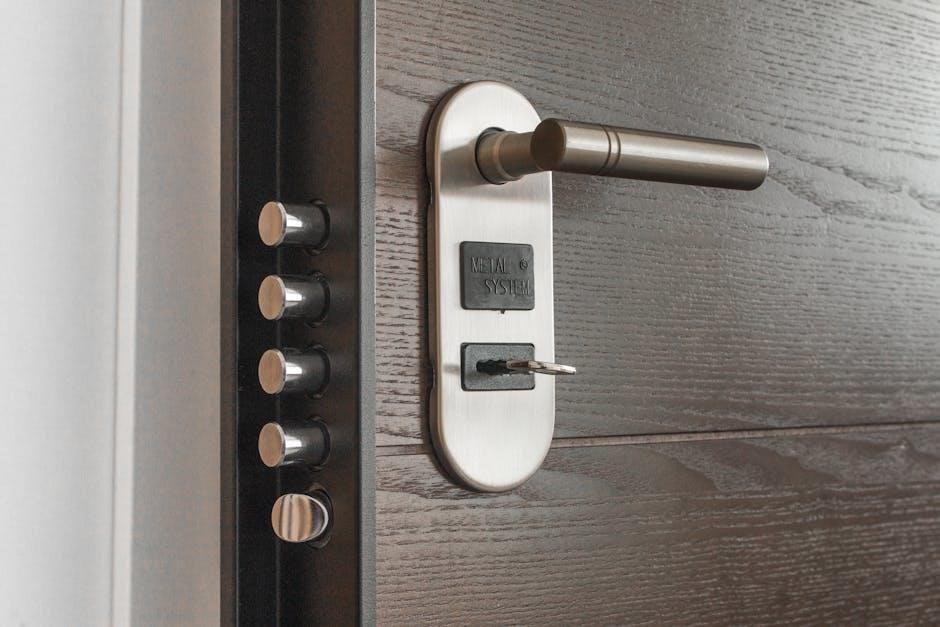Lexus Manual Key Won’t Open Door: Troubleshooting Guide
Encountering a situation where your Lexus manual key refuses to
unlock the door can be frustrating and unsettling. This guide
provides a systematic approach to understanding and resolving this
issue. We will explore potential causes and troubleshooting steps,
ensuring you regain access to your vehicle efficiently and safely.
The inability of your Lexus manual key to open the door can stem from
various underlying issues. It’s crucial to approach the problem
methodically to identify the root cause and implement the appropriate
solution. This troubleshooting guide aims to provide a comprehensive
understanding of the potential reasons behind this malfunction and equip
you with the knowledge to address it effectively.
Several factors can contribute to a non-functional manual key, ranging
from simple issues like a dead battery in the key fob affecting the
entire locking system to more complex mechanical problems within the door
lock mechanism itself. External factors, such as a frozen lock in cold
weather, or internal issues like linkage problems inside the door, can
also prevent the manual key from working correctly. Furthermore,
electrical issues, such as a blown fuse affecting the door locks, can
render the manual key useless. Understanding these potential causes is
the first step in diagnosing and resolving the problem.
This guide will walk you through a step-by-step troubleshooting process,
starting with the simplest solutions and progressing to more advanced
diagnostics. We’ll cover everything from lubricating the lock cylinder
to exploring emergency opening procedures and knowing when to seek
professional assistance. By following this guide, you’ll be well-equipped
to tackle this issue and regain access to your Lexus.
Possible Causes for a Non-Functional Manual Key
Several factors can contribute to your Lexus manual key’s inability to
open the door. Understanding these potential causes is crucial for
effective troubleshooting. One common reason is a dead battery in the
key fob, which, while primarily affecting remote unlocking, can sometimes
interfere with the manual locking mechanism as well. The system might
rely on some electrical assistance even when using the manual key.

Mechanical issues within the lock cylinder itself are also frequent
culprits. These can include worn or dirty lock cylinders and tumblers,
lack of lubrication, or even a damaged tailpiece (turn piece) of the
lock. Over time, the intricate components within the lock can accumulate
dirt and debris, hindering their smooth operation. Similarly, the
absence of proper lubrication can cause friction and prevent the key from
turning freely.
Another possibility is linkage problems inside the door. The linkage
connects the lock cylinder to the actual door latch, and if this linkage
is broken, loose, or disconnected, turning the key will not translate
into unlocking the door. In colder climates, a frozen lock mechanism can
also be the cause, especially if moisture has accumulated inside the
lock cylinder. Finally, though less common, a blown fuse affecting the
door locks could also impact the manual key’s functionality, particularly
if the system has some level of electrical integration with the manual
mechanism.
Dead Battery in Key Fob
While a dead battery in your Lexus key fob primarily impacts remote
functions like unlocking doors and starting the car, it can indirectly
affect the manual key’s operation. Modern vehicles often integrate the
manual lock with the electronic security system. A completely drained
fob battery may prevent the system from disarming, thus hindering the
mechanical key from fully engaging the locking mechanism. Consider it a
security failsafe, preventing unauthorized access even with a physical
key.
The key fob battery typically lasts for one to two years, depending on
usage. Signs of a weakening battery include reduced range for remote
functions or needing to press buttons multiple times. However, sometimes
the battery dies suddenly without warning. Replacing the battery is a
relatively simple process. Consult your Lexus owner’s manual for the
correct battery type and instructions.
If replacing the battery resolves the issue, it confirms that the dead
fob was indeed the culprit. However, if the manual key still doesn’t
work after a battery replacement, it indicates that another problem is
at play. In this case, you will need to investigate other potential
causes, such as mechanical issues with the lock cylinder, linkage
problems, or a frozen lock mechanism. Remember that even with a dead
fob, the mechanical key should ideally override the system, but the
integrated security can sometimes cause unexpected behavior.
Mechanical Issues with the Lock Cylinder
The lock cylinder is the physical component where you insert the manual
key. Over time, this cylinder can develop mechanical issues that prevent
the key from turning or properly engaging the locking mechanism. One
common problem is worn or damaged tumblers inside the cylinder. Tumblers
are small, precisely shaped pieces that align to allow the key to turn.
If these tumblers become worn, bent, or broken, the key may not be able
to properly align them.
Another potential issue is a foreign object lodged inside the cylinder.
Dirt, debris, or even a broken piece of key can obstruct the tumblers
and prevent the key from fully inserting or turning. Corrosion can also
build up inside the cylinder, especially in areas with high humidity or
exposure to road salt. This corrosion can cause the tumblers to stick or
seize, making it difficult to turn the key.
Attempting to force the key can exacerbate the problem, potentially
damaging the key or the cylinder further. A visual inspection of the key
and the cylinder opening can sometimes reveal obvious obstructions or
damage. If you suspect a mechanical issue with the lock cylinder, it is
best to avoid forcing the key and instead try lubricating the cylinder
or seeking professional help from a locksmith or mechanic. They have
the tools and expertise to diagnose and repair or replace the lock
cylinder if necessary.
Linkage Problems Inside the Door
Inside your Lexus door resides a series of rods and levers, collectively
known as the linkage, which connect the lock cylinder to the actual
latching mechanism. When you turn the key, this linkage translates that
rotational movement into the linear motion needed to unlock the door. If
any part of this linkage becomes disconnected, bent, or broken, the key
will turn, but the door will not unlock.

One common issue is a loose or detached connecting rod. These rods are
typically held in place by plastic clips or fasteners, which can degrade
or break over time. When a rod becomes detached, it loses its ability
to transfer the movement from the key cylinder to the latch. Similarly,
if a rod becomes bent, it may bind against other components inside the
door, preventing the mechanism from moving freely.
Another potential problem is a broken lever or actuator within the
linkage. These components are often made of plastic or cast metal and
can fatigue or break under stress. If a lever breaks, it disrupts the
mechanical connection between the key cylinder and the latch. Diagnosing
linkage problems typically requires removing the interior door panel to
inspect the components. This can be a complex task, as the linkage is
often located in a tight space and may be difficult to access. If you
are not comfortable disassembling the door panel, it is best to seek
professional assistance.
Frozen Lock Mechanism
In regions experiencing cold weather, a frozen lock mechanism can be a
significant cause of a manual key failing to open a Lexus door. Moisture,
such as rain, snow, or condensation, can seep into the lock cylinder and
freeze when temperatures drop below freezing. This ice formation can
obstruct the tumblers within the lock, preventing the key from turning
or engaging properly.
The most obvious sign of a frozen lock is the key’s inability to turn
fully or at all, even with moderate force. Attempting to force the key
can risk damaging the key or the lock cylinder itself. Before resorting
to more drastic measures, try warming the key. Holding the key in your
hand or using a lighter (carefully and briefly) can transfer enough heat
to melt the ice within the lock.
Another approach involves using a commercial de-icer specifically designed
for automotive locks. These products typically contain alcohol or other
solvents that lower the freezing point of water, effectively melting the
ice. Apply the de-icer directly into the lock cylinder and allow it to
penetrate for a few minutes before attempting to turn the key again. In
severe cases, you may need to repeat the process. Avoid using hot water,
as it can cause further problems by refreezing and potentially damaging
the lock components. Once the lock is thawed, consider lubricating it
with a silicone-based lubricant to prevent future freezing.
Fuse Problems Affecting Door Locks
While a manual key should mechanically unlock the door, certain electrical
issues, specifically blown fuses, can indirectly impact the door lock
system’s functionality, especially if the vehicle has electronic locking
components integrated with the manual system. In modern vehicles, a fuse
protects the power circuits that control various functions, including the
door locks. If the fuse responsible for the door locks blows, it can
disrupt the electrical signals needed for the locking mechanism to
operate correctly, even when using the manual key.
A blown fuse can prevent the door from unlocking, even if the manual key
turns in the lock cylinder. This is because the electrical components
that release the locking mechanism might not receive the necessary power.
To check for a blown fuse, consult your Lexus owner’s manual to locate
the fuse box and identify the fuse associated with the door locks.
Visually inspect the fuse. A blown fuse typically has a broken filament.
If you identify a blown fuse, replace it with a new fuse of the same
amperage rating. After replacing the fuse, test the door lock using the

manual key. If the door unlocks, the fuse was the problem. However, if
the fuse blows again shortly after replacement, it indicates a more
significant electrical issue, such as a short circuit in the door lock
system, requiring professional diagnosis and repair.
Troubleshooting Steps
When your Lexus manual key fails to open the door, a systematic
troubleshooting approach is essential. Start by verifying the key itself.
Ensure it’s the correct key for your vehicle and that it’s not damaged or
bent. Try wiggling the key gently in the lock cylinder while attempting to
turn it. This can sometimes help overcome minor obstructions or
misalignments within the lock mechanism. Next, inspect the lock cylinder
for any visible signs of damage, dirt, or debris.
If possible, try using the manual key on other doors of the vehicle to
rule out a problem specific to one door’s lock cylinder. If the key works
on other doors, the issue is likely isolated to the problematic door.
Consider the environmental conditions. Extreme temperatures, such as
freezing weather, can cause the lock mechanism to stick. In such cases,
try warming the lock cylinder with a hairdryer (on a low setting) or a
warm cloth.
If the key still doesn’t work, attempt to lubricate the lock cylinder. Use
a lubricant specifically designed for locks, such as a graphite-based
lubricant or a silicone spray. Avoid using oil-based lubricants, as they
can attract dirt and debris over time, potentially worsening the problem.
Insert the lubricant into the lock cylinder and work the key in and out
several times to distribute the lubricant evenly. After lubricating, try
the key again.
Lubricating the Lock Cylinder
If your Lexus manual key isn’t functioning correctly, lubricating the lock
cylinder is a crucial step. Over time, dirt, debris, and corrosion can
accumulate within the cylinder, hindering the key’s ability to turn
smoothly. Before you begin, gather the necessary supplies: a suitable
lock lubricant (graphite-based or silicone spray is recommended), a clean
cloth, and the manual key itself. Avoid using oil-based lubricants, as
they can attract more dirt and worsen the problem in the long run.
Begin by inserting the nozzle of the lubricant into the keyhole of the lock
cylinder. Apply a small amount of lubricant, being careful not to overdo
it. Less is often more in this case. Next, insert the manual key into the
lock cylinder and gently work it back and forth, as well as in and out,
several times. This action helps distribute the lubricant evenly
throughout the internal mechanisms of the lock. Wipe away any excess
lubricant that may seep out of the keyhole using the clean cloth.
After working the key for a few minutes, remove it and inspect it for any
dirt or debris that may have been dislodged from the lock cylinder. Clean
the key thoroughly before reinserting it. Repeat the process of inserting
the key, working it back and forth, and wiping away excess lubricant
several times until the key turns smoothly and the lock mechanism feels
less resistant. If the key still doesn’t turn after multiple attempts,
consider seeking professional assistance.
Emergency Opening Procedures
When a Lexus manual key fails to open the door, and standard
troubleshooting steps have been exhausted, emergency opening procedures
become necessary. These procedures should only be attempted if you are
certain that no other options are available, as they may involve a degree
of risk to your vehicle. The first step is to double-check that you are
using the correct key for the vehicle. It may seem obvious, but
mistakes happen, especially in stressful situations. Ensure the key is
fully inserted into the lock cylinder.

If the correct key is being used, and it is fully inserted, try applying
gentle but firm pressure while turning the key. Avoid excessive force, as
this could damage the key or the lock mechanism. While applying pressure,
try wiggling the key slightly to help it engage with the internal
tumblers. If the key still refuses to turn, consider using a specialized
lock picking tool, if you have experience with such tools. However, it’s
crucial to exercise extreme caution, as improper use can cause significant
damage to the lock cylinder.
Another approach involves using a slim jim or a similar tool to manipulate
the door’s locking mechanism from the inside. This method requires
knowledge of the vehicle’s internal structure and should only be attempted
by individuals with experience. If you are not comfortable with these
methods, it is best to contact a professional locksmith or roadside
assistance service. They have the expertise and tools necessary to open
the door without causing further damage to your Lexus.
When to Seek Professional Help
While many Lexus manual key issues can be resolved with simple
troubleshooting, certain situations warrant professional assistance. If
you’ve tried lubricating the lock cylinder, checked for obvious
obstructions, and attempted emergency opening procedures without success,
it’s time to consult a qualified locksmith or automotive technician.
Continuing to force the key or manipulate the lock mechanism can cause
irreversible damage, leading to more costly repairs.
If you suspect a mechanical issue within the door, such as a broken
linkage or a faulty latch, professional intervention is necessary. These
components are complex and require specialized tools and knowledge to
diagnose and repair. Similarly, if the key turns in the lock but the door
doesn’t open, it could indicate a problem with the door’s internal
mechanisms, which a professional can address effectively.
Another scenario that calls for professional help is when the key is
damaged or broken inside the lock cylinder. Attempting to remove the
broken key yourself can further damage the lock, making extraction more
difficult. A locksmith has the tools and expertise to safely remove the
key without causing additional harm. Furthermore, if you’re unsure about
the cause of the problem or feel uncomfortable attempting any of the
troubleshooting steps, seeking professional assistance is always the best
course of action. A skilled technician can accurately diagnose the issue
and provide the appropriate solution, ensuring your Lexus is back in
working order.


